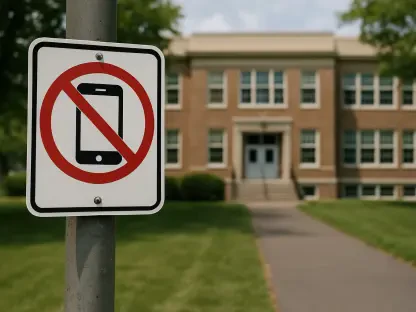The integration of artificial intelligence (AI) into K-12 education is rapidly transforming the traditional classroom setting, promising both significant opportunities and formidable challenges. As school districts navigate this technological landscape, several pivotal trends are emerging that will shape the future of education by 2025. This article delves into these trends, highlighting the developments and obstacles that educators and policymakers must address to fully leverage AI’s potential in transforming education.
Increasing Importance of District and State Guidance
As AI becomes more ingrained in educational practices, the role of district and state guidance is becoming increasingly critical. With federal direction on AI policies remaining ambiguous, schools are turning to national organizations and nonprofits for much-needed support. Experts, such as Kris Hagel, Chief Information Officer of Peninsula School District, predict that state education agencies will take the lead in establishing AI-related policies. By November, 24 states had already released AI guidance for education, suggesting a shift towards localized policy development.
This move towards state and district-level guidance indicates that more school districts and states will create and rely on their own AI policies and resources in the coming years. While the U.S. Department of Education’s Office of Educational Technology has made some strides in providing AI resources, there is still uncertainty about the continuity of this support at the federal level. Pat Yongpradit, Chief Academic Officer of Code.org, emphasizes the importance of state-led initiatives in navigating the complexities of AI integration, ensuring effective and equitable implementation across schools.
State education agencies are expected to play a pivotal role, providing the necessary guidance and resources to schools as they grapple with the multifaceted nature of AI integration. This localized approach could foster a more responsive and tailored adoption of AI technologies, addressing unique regional needs and challenges. However, the continued evolution and support of these state-led policies will be crucial in maintaining momentum and ensuring that all schools, regardless of location, can harness the full benefits of AI in education.
Customization of AI Tools for Special Education and English Learners
AI’s potential to revolutionize special education and support English learners marks a significant trend in K-12 education. Educators in the special education sector are showing increased interest in AI, anticipating the development of more tailored solutions for these student groups. At Peninsula School District, efforts are already underway to analyze students’ Individualized Education Programs (IEPs) using the district’s AI enterprise system, with the goal of enhancing the effectiveness of IEPs through data-driven insights. This approach could lead to more personalized and impactful educational experiences for students requiring additional support.
Kris Hagel advises caution against using free, publicly available AI tools like ChatGPT for special education, underscoring the importance of secure AI environments that safeguard data privacy. Robin Lake, Director of the Center on Reinventing Public Education at Arizona State University, shares this sentiment and predicts that more AI tools will emerge to support multilingual learners. Real-time translation tools are expected to become more integrated into classrooms, bolstering language learning and helping create a more inclusive educational environment.
These advancements in AI technology will provide educators with powerful tools to address the diverse needs of their students. By customizing AI tools to cater to specific requirements, such as those in special education and for English learners, schools can foster a more inclusive and effective learning environment. The integration of AI has the potential to break down language barriers, provide personalized feedback, and enhance the learning experience for students who may struggle in a traditional classroom setting. Such strides could transform the educational landscape, making it more equitable and accessible for all students.
Growing Use of AI Detection Tools by Teachers
As AI becomes more widespread in schools, the need for tools to detect AI-generated content and prevent academic dishonesty is growing. Teachers are increasingly relying on AI detection tools to identify AI-generated text, a trend that is expected to continue through 2025. Pat Yongpradit anticipates that more educators will adopt these detection tools, although he also foresees potential public pushback against their use. This highlights a growing concern about the balance between leveraging technological solutions and maintaining an engaging and honest academic environment.
Yongpradit advises educators to reconsider the underlying motivations for teaching and assess why students might resort to cheating. While AI detection tools can be useful, they may not provide a comprehensive solution to academic dishonesty. Instead, educators should explore ways to enhance the overall learning experience, addressing the root causes of why students might cheat. This could involve creating more engaging teaching methods, offering personalized feedback, and fostering a supportive learning atmosphere.
Robin Lake suggests that beyond detection, AI tools could provide real-time feedback and targeted professional development for teachers. Additionally, AI tutors could offer personalized instruction for students, further enhancing the educational experience and reducing the reliance on detection tools. By focusing on improving the learning environment and utilizing AI for positive reinforcement and guidance, schools can create a more effective and ethical approach to education. This can help shift the focus from merely detecting dishonesty to fostering genuine learning and growth among students.
Disparities in AI Adoption Across School Districts
The incorporation of artificial intelligence (AI) into K-12 education is swiftly changing the conventional classroom environment, offering both considerable advantages and significant challenges. As school districts adapt to this technological era, several key trends are emerging that will define the future of education by 2025. This article explores these trends, emphasizing the innovations and hurdles that teachers and policymakers must address to fully harness AI’s potential in revolutionizing education.
AI’s integration promises personalized learning experiences tailored to each student’s needs, potentially improving educational outcomes. However, it also raises concerns about data privacy, the digital divide, and the necessity for teacher training to effectively use AI tools. As we approach 2025, educators must balance these opportunities and challenges to create an equitable learning environment. Policymakers must prioritize policies that address these issues, ensuring that AI benefits all students while safeguarding their privacy and providing teachers with the necessary resources and training to succeed in this new era of education.









